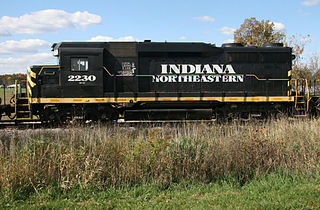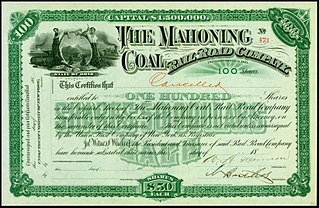
The New York Central Railroad was a railroad primarily operating in the Great Lakes and Mid-Atlantic regions of the United States. The railroad primarily connected greater New York and Boston in the east with Chicago and St. Louis in the Midwest, along with the intermediate cities of Albany, Buffalo, Cleveland, Cincinnati, Detroit, Rochester and Syracuse. New York Central was headquartered in New York City's New York Central Building, adjacent to its largest station, Grand Central Terminal.
The Lake Shore and Michigan Southern Railway, established in 1833, and sometimes referred to as the Lake Shore, was a major part of the New York Central Railroad's Water Level Route from Buffalo, New York, to Chicago, Illinois, primarily along the south shore of Lake Erie and across northern Indiana. The line's trackage remains a major rail transportation corridor used by Amtrak passenger trains and several freight lines; in 1998, its ownership was split at Cleveland, Ohio, between CSX Transportation to the east and Norfolk Southern Railway in the west.

The Michigan Central Railroad was originally chartered in 1832 to establish rail service between Detroit, Michigan, and St. Joseph, Michigan. The railroad later operated in the states of Michigan, Indiana, and Illinois in the United States and the province of Ontario in Canada. After about 1867 the railroad was controlled by the New York Central Railroad, which later became part of Penn Central and then Conrail. After the 1998 Conrail breakup, Norfolk Southern Railway now owns much of the former Michigan Central trackage.

The Great Lakes Central Railroad is an American shortline railroad, operating in the state of Michigan. It was originally called the Tuscola and Saginaw Bay Railway, which was formed on August 26, 1977, to operate over former Penn Central lines from Millington to Munger, and from Vassar to Colling. TSBY's name was derived from the three counties it operated in: Tuscola, Saginaw and Bay.
The Cleveland Short Line Railway is a freight bypass around southern Cleveland, Ohio, in the United States. A quasi-independent railroad organized by major shareholders of the Lake Shore and Michigan Southern Railway, the shortline was intended to allow the Lake Shore and Michigan Southern to bypass the congested railroads in downtown Cleveland. The Cleveland Short Line has had a succession of owners, and is currently part of CSX Transportation.
The Michigan Air Line Railroad was a railroad company in the United States. It was incorporated in 1868 and constructed a line between Jackson, Michigan, and South Bend, Indiana. The Michigan Central Railroad leased the company in 1871 and merged it in 1916. The New York Central Railroad leased the Michigan Central in 1930. The Michigan Air Line Railroad also built a short line between Romeo, Michigan, and Richmond, Michigan, which became part of the Michigan Air Line Railway, a predecessor of the Grand Trunk Western Railroad.
The Pittsburgh, Fort Wayne and Chicago Railway was a major part of the Pennsylvania Railroad system, extending the PRR west from Pittsburgh, Pennsylvania, via Fort Wayne, Indiana, to Chicago, Illinois. It included the current Norfolk Southern-owned Fort Wayne Line east of Crestline, Ohio, to Pittsburgh, and the Fort Wayne Secondary, owned by CSX, from Crestline west to Tolleston in Gary, Indiana. CSX leased its entire portion in 2004 to the Chicago, Fort Wayne and Eastern Railroad (CFE). The remaining portion of the line from Tolleston into Chicago is now part of the Norfolk Southern's Chicago District, with a small portion of the original PFW&C trackage abandoned in favor of the parallel lines of former competitors which are now part of the modern NS system.

Railroads have been vital in the history of the population and trade of rough and finished goods in the state of Michigan. While some coastal settlements had previously existed, the population, commercial, and industrial growth of the state further bloomed with the establishment of the railroad.

The Indiana Northeastern Railroad is a Class III short line freight railroad operating on nearly 130 miles (210 km) in southern lower Michigan, northeast Indiana and northwest Ohio. The Indiana Northeastern Railroad Company began operations in December 1992 and is an independent privately owned company. As of 2017 the railroad hauled more than 7,000 carloads per year. Commodities moved by the railroad include corn, soybeans, wheat and flour. It also handles plastics, fiberboard, aluminum, copper, coal, perlite, stone, lumber, glass, rendering products, as well as agricultural fertilizers and chemicals.

The Chicago, Kalamazoo and Saginaw Railway (CK&S), known informally as the "Cuss, Kick & Swear" is a defunct railroad which operated in southwest Michigan in the late 19th and early to mid 20th centuries. Despite the name, the line ran entirely within the state of Michigan, with the majority in Kalamazoo County. It eventually became part of the New York Central. As of 2010, most of the former CK&S tracks have since been abandoned.

The St. Joseph Valley Rail Road is a defunct railroad which operated in southern Michigan during the mid-19th century.

The Paul Henry–Thornapple Rail Trail is a rail trail that when complete will be 42 miles (68 km) long, running from Grand Rapids to Vermontville, Michigan. The trail closely follows the original route of the Grand River Valley Railroad, constructed in 1868-69 and in operation from 1870 to 1983. The trail is managed by multiple different agencies. The trail has multiple paved sections still to be connected, with a 21⁄2 mile gap between Caledonia and Middleville, a 5-mile gap between Middleville and Hastings, and multiple smaller gaps between Hastings and Nashville. Completed sections of the trail have a 10-foot (3.0 m) wide paved surface with a gravel shoulder. The longest paved section of trail is within Kent county between the trail terminus at Kalamazoo Ave in Kentwood and 108th St in Caledonia Township. The trail has connections with the Frederik Meijer Trail and the East-West Trail, both in Kentwood. A section of the trail from Irving to Middleville is part of the North Country National Scenic Trail.
The following is a brief history of the North American rail system, mainly through major changes to Class I railroads, the largest class by operating revenue.
The Palmyra Jacksonburgh Railroad, located in Southern Michigan, was the first railway system in the state of Michigan. It was abandoned in 1981 but is now an active railroad museum.

The Vandalia Railroad Company was incorporated January 1, 1905, by a merger of several lines in Indiana and Illinois that formed a 471-mile railroad consisting of lines mostly west of Indianapolis.

The Mahoning Coal Railroad (MCR) was a railroad line in the U.S. states of Ohio and Pennsylvania. Incorporated in 1871, it largely linked Youngstown, Ohio, with Andover, Ohio. It had a major branch into Sharon, Pennsylvania, and several small branches and spurs to coal mines and iron works along the Ohio-Pennsylvania border. The railroad leased itself to the Lake Shore and Michigan Southern Railway in 1873. The lease was assumed by the New York Central Railroad in 1914, when that company consolidated with the Lake Shore & Michigan Southern. The New York Central merged with the Pennsylvania Railroad in 1968 to create the Penn Central. Despite abandonment of much track, bankruptcy of the Penn Central in 1970 eventually caused the MCR's dissolution on January 7, 1982.
The Detroit, Monroe and Toledo Railroad (DM&T) was a shortline railroad which operated in the U.S. states of Michigan and Ohio. Opened in 1856, its main line ran from Detroit, Michigan, to Toledo, Ohio. The railroad leased itself to the Michigan Southern and Northern Indiana Railroad (MS&NI) in 1856. A 1914 merger which created the New York Central Railroad led to the DM&T's consolidation into the new road, ending its existence.
The Fort Wayne and Jackson Railroad was a railway company in the United States. It was incorporated in 1879 to reorganize the Fort Wayne, Jackson and Saginaw Railroad, which owned a railway line between Fort Wayne, Indiana, and Jackson, Michigan. The Lake Shore and Michigan Southern Railway leased the company in 1882. Most of the company's line has been abandoned.
The Morenci branch or Fayette branch was a railway line in the states of Michigan and Ohio. It ran 25.21 miles (40.57 km) from Grosvenor, near Blissfield, Michigan, to Fayette, Ohio. It was built by the Chicago and Canada Southern Railway in 1872 as part of abortive attempt to construct a new through route between Southern Ontario and Chicago. The branch became part of the Lake Shore and Michigan Southern Railway system, and from there passed on to the New York Central Railroad and Penn Central. Following the Penn Central's bankruptcy, the state of Michigan acquired the line and abandoned it in 1991.










